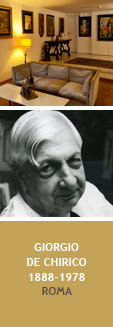Rome
The Giorgio de Chirico House-museum is located on the 4th floor of Palazzetto Borgognoni, 31 Piazza di Spagna, Rome. The artist moved there, together with his second wife, Isabella Far Pakszwer, in 1947 where he lived until his death in 1978.
His move to Palazzetto dei Borgognoni marked an important change for the artist: after years of moving around and living in various Italian and foreign cities, he decided to finally settle down in “the centre of the centre of the world”, a stone’s throw away from the Spanish Steps.
Spread over three floors – two of which are open to the public – the apartment’s first floor features an entrance hall, two living rooms, a dining room and the Foundation’s offices, which, in times past, once contained the kitchen. The second floor is more intimate and creative in nature, owing to the location of Giorgio and Isa’s separate bedrooms and the artist’s studio.
A visit to the de Chirico House-museum provides the visitor with the rare opportunity of experiencing the following three facets of the artist’s life:
Intimate and familiar: the house is filled with original furnishings and personal belongings;
Artistic: the first floor features a permanent exhibition of his paintings and sculpture dating from the 1930s onwards;
Creative: the reconstructed artist’s studio gives the visitor a taste of where and how de Chirico worked for over 30 years. Original picture frames, paints, brushes, antique casts, books – all illuminated by the overhead skylight which provided a direct source of light for the artist whilst painting – successfully revoke the atmosphere in which he worked.
His move to Palazzetto dei Borgognoni marked an important change for the artist: after years of moving around and living in various Italian and foreign cities, he decided to finally settle down in “the centre of the centre of the world”, a stone’s throw away from the Spanish Steps.
Spread over three floors – two of which are open to the public – the apartment’s first floor features an entrance hall, two living rooms, a dining room and the Foundation’s offices, which, in times past, once contained the kitchen. The second floor is more intimate and creative in nature, owing to the location of Giorgio and Isa’s separate bedrooms and the artist’s studio.
A visit to the de Chirico House-museum provides the visitor with the rare opportunity of experiencing the following three facets of the artist’s life:
Intimate and familiar: the house is filled with original furnishings and personal belongings;
Artistic: the first floor features a permanent exhibition of his paintings and sculpture dating from the 1930s onwards;
Creative: the reconstructed artist’s studio gives the visitor a taste of where and how de Chirico worked for over 30 years. Original picture frames, paints, brushes, antique casts, books – all illuminated by the overhead skylight which provided a direct source of light for the artist whilst painting – successfully revoke the atmosphere in which he worked.








